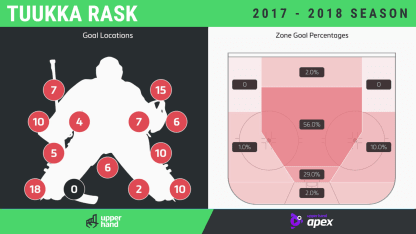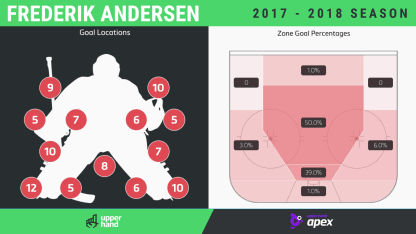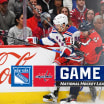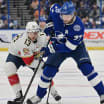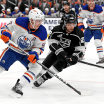Early butterfly: If there was one thing that jumped out amid Rask's recent struggles, it was how early he was dropping to the butterfly; not in terms of dropping early on shots, but more cases of him sliding across the crease on his knees on plays we'd normally expect him to handle on his skates. He wasn't getting a lot of help defensively, however. Of the 100 goals tracked, 50 came after a pass or play across the slot line, an imaginary line that splits the offensive zone from the goal line to the top of the face-off circles. That's well above the 33.9 percent average of tracked goals while breaking down playoff goalies for this project during the past two seasons. These plays are hardest for goalies because it forces them change their angle from one side to the other before a quick shot. Twenty-one of 50 "slot line" goals against Rask came after Feb. 15. Add in another 21 goals on lateral plays that did not cross the slot line but at least forced Rask to change his angle and its clear forcing him to move is key to scoring.
Low and wide: Last season, Rask gave up 26 percent of his goals along the ice outside of his skates; this season it was 28 percent, with the biggest number of those going in low to his right. It's often an indication of a back-door play and, certainly, the number of slot-line chances he faced played a role in many of those goals. But the way Rask plays these rushes, often starting outside his posts laterally before the initial pass also makes it harder for him to recover that space on quick shots, which accounted for 44 percent of his goals this season.
Post play: Rask continued to modernize his post-integration habits during the season, using his back leg more to pivot around and move off his posts from reverse-VH. He eliminated some of the inherent exposure from his old tendency to go into the posts with the shin of his pad and "bump" off them with a narrow butterfly that limited his coverage along the ice. It showed with only 12 goals on low-high and sharp-angle plays, compared to 21 last season.
Notable numbers: Rask's numbers mid-to-high on the glove and blocker sides were at, or lower than, average; but he allowed several goals on clean shots off the rush. His pattern of drifting back in straight lines, not staying square to shooters down the wing, was a factor. It shows up more on his blocker side with 10 percent of goals from outside the home plate area.

